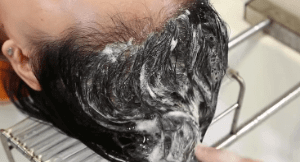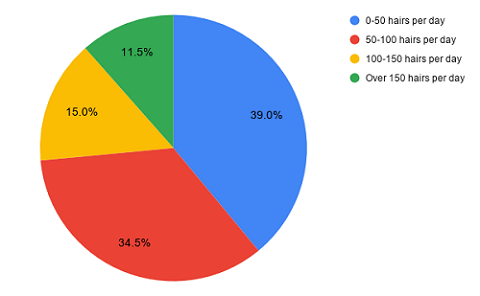A popular statistic on the internet is that it is normal to lose over 100 hairs per day. Some even suggest that men and women both shed up to 150 scalp hairs per day. I think that these numbers are excessive for most people who do not suffer from male or female pattern hair loss.
The AAD says that normal hair loss is between 50-100 hairs per day based on a regular cycle. Anything beyond that is excessive shedding and considered telogen effluvium. Such hair loss is usually stress, sickness or fad diet related, and temporary in nature.
 Before I started taking Dutasteride, it was normal for me to see over 150 hairs every day just on my bathtub floor and drain after showering. Even more would be visible on my pillowcase, hair brush after combing, towel and more. In my teenage years, I lost very little hair (less than 20 per day) even if I strongly pulled on each follicle. I also washed and shampooed my hair far less often in my younger days. It was naturally cleaner, manageable and dandruff free.
Before I started taking Dutasteride, it was normal for me to see over 150 hairs every day just on my bathtub floor and drain after showering. Even more would be visible on my pillowcase, hair brush after combing, towel and more. In my teenage years, I lost very little hair (less than 20 per day) even if I strongly pulled on each follicle. I also washed and shampooed my hair far less often in my younger days. It was naturally cleaner, manageable and dandruff free.
Please closely read all the options in the below poll before voting.
Poll: How Many Hairs do you Shed Every Day?
Since the poll was slowing down this site, I ended it early. Final results are shown below based on a total of 250 votes:

Speaking of how many hairs per day, I would love to get a quick update from Gabriel on his shedding. Has it gone down after a month along with his immediate itching?
I don’t count anymore…
I just want ONE Story hairloss cure is HERE NOW.
Outside of that, it is not about losing hair but about having it grow back (which does not happen anymore and why people go bald).
I feel like we can wait a long time before we get the only article we actually want to read
Admin, how many hairs do you lose now that you are on dut? I’m thinking of adding 1 pill dut a week to my fin regime. Fin working pretty well
Usually less than 50 is my guess. Sometimes even less than 5 affer the shower, which is a miracle. However, I also have a lot less hair than 15 years ago.
I assume it stays in that 50 to 100 range with mpb although the hairs just dont return. It’s too bad we have a month till 2020 and there is no end in sight.
Any news on Replicel/Shiseido?
Probably around 10 in shower and styling with blow dryer. After that I rarely see any hair shedding through out the day. Probably 30 to 50 tops. However this may be normal range but im still diffusing
Anyone else experience seasonal changes in shedding? In spring and summer, my shedding seems minimal, but in autumn, leaves aren’t the only thing that’s falling here. Like, yearly, it’s a noticeable difference. My wife even notices.
Yes Al opecia. My hair sheds in Sept or October each year. Duffuse. I get some regrowth around late Dec to feb. Then another shed in April which then grows back in June. It’s a giant pain in the as%. Ups a s downs.
Fyi…someone on hlt posted a picture of follica results. 3 months. Crown has visible improvement. Nothing ground breaking. Plus not sure if it’s a new pic or what. Slide is somewhat ambiguous since it states topline results in 2020. So not sure if this a pic of follica or just a general pic of hair loss drugs current available like Rogaine Propecia at 3 months?
It is about as relevant as the colour of your comb.
Shedding is when the follicle releases the hair shaft. A healthy follicle will grow a new one no problem. Shed all you want.
Hair loss is when the follicle gets smaller and weaker, producing thinner hair and eventually no hair.
Mjones, for Follica…
…Go to Page 39-40 in this Presentation:
https://www.puretechhealth.com/images/PureTech-Corporate-Presentation_FINAL-111919-Web.pdf
(Picture of Sample patient outcome from FOL-004 interim data)
· Follica is developing an approximately five-minute in-office experimental procedure associated with limited downtime
· Follica’s approach is comprised of a proprietary device designed to stimulate hair follicle growth, followed by treatment with a pharmaceutical compound to thicken and maintain newly created hair follicles
· Interim data from an ongoing safety and optimization study (N=20) showed that Follica’s approach achieved a statistically significant increase in non-vellus (visible) hair count after three months of treatment compared to baseline
· Blinded head-to-head bench testing of the proprietary Follica device has shown advantages in scalp treatment versus commercially available skin disruption devices
· Topline results from pivotal study and subsequent NDA filing with the FDA, if data are supportive, are *expected in 2020*
This is unbelievable news!
FOL-004 is currently ‘Phase 2 in Progress’. (Pg. 7)
Upcoming Timeline can be found on Page 32.
2019: Interim clinical readout of optimization study in AGA
2020: Topline Results from Pivotal Study in AGA & FDA Filing
I think Follica will be the first new treatment on the market. Quite possibly 2020 : )
(Here’s the source again: https://www.puretechhealth.com/images/PureTech-Corporate-Presentation_FINAL-111919-Web.pdf)
Nice Find!
Thanks for posting this – looking forward to hearing more about it….I wonder how often a patient has to go to get the in-office treatment.
Is it me or is there comb over effects going on in that before after crown picture from follica? I’m hoping that isn’t the best regrowth they got. I understand it’s 90 days into treatment but…… with all the millions of dollars in funding and trials I was expecting full coverage of a bald spot like that. It looks like the bottom part of the crown was combed to the left and the top part of the crown combed to the left to shrink the spot.
What do you guys think?
They did mention top line results to come in 2020 so maybe this isn’t it ?
@Mjones – I see what you mean on the bottom part of the man’s crown area. But, there is significant regrowth throughout the crown. Not ideal, but it appears far better than minoxidil.
I wonder what the cost will be and once again, how often users would have to go in-office. Might be a nice interim improvement for hairloss sufferers until something more ideal comes along.
Hey I’m a little late to this party but wanted to add my two cents.
I started having noticeable shedding in high school. I remember seeing hairs fall into my notebook while doing homework late at night and having to wipe them off on a regular basis.
I’m now 33 with a NW3 hairline. Looking back on things I could have probably stopped/ slowed the receding had I taken propecia around the age of 25 but I decided not to. While I may have fallen victim to being scared of the sides, I also didn’t want to play with my hormones and create unwarranted effects beyond lower sex drive (which probably would have been actually useful for me in my mid 20s – more time to focus). It seemed to be a big risk to me then and still does now.
All that aside, during this entire time of moving from a nw1 to a nw3, I have been obsessed with my hair as most of you can understand, so I would actually count my hairs in the sink after styling it. Most days I would find 50-70. I would also run my fingers through my hairline, close my fingers and light pull up to check how many hairs would be caught between my fingers. I would find anywhere from 5 to 10 hairs every time I did that action. It was amazing to me that I wasn’t balding faster as I would guess that I was probably losing 200 hairs / day.
Fast forward today and I can say that I am definitely a strong NW3. I tend not to notice as many hairs in the sink and when I do the same action with my fingers, I typically pull just one hair up. Is it because I have less hair? Is it because my hormones have settled down? Is it because my alopecia has stopped? Also, have any of you noticed the same thing happen?
I ask those questions because I see a lot of people in my position: NW3 and holding on. It’s a frustrating place to be, it’s limbo. We still have hair but it’s not what we wish to have. We could shave it off but we’re in a position that we can still pass off as having hair. It’s limbo and with that limbo we left in a space of waiting for the inevitable so we can find acceptance either through full baldness, a hair system, a transplant or whatever it may be.
I will say this as I always have. My holy grail treatment is not to grow hair back from Nw7 to NW1 nor NW3 to nw1. It is to stabilize the loss without playing with our hormones (hopefully with a novel product or procedure) so we can use the techniques that are available today (hair transplants) to have the hairlines we want. Stabilization, not cloning/ regrowth, is the key – that is our holy grail. I will continue to say that after I am bald and I truly believe that a product that stabilizes would be useful for most to all of us.
I think if companies knew this they would have released a product a long time ago. If they could provide another way to stabilize our hair without playing with our internal chemistry/ biology/ hormones on a systemic level, people would like up for it. If I knew that my hairline was going to sit where it is today for the next 20 years, I would go in for a hair transplant tomorrow. But I don’t.
Cheers